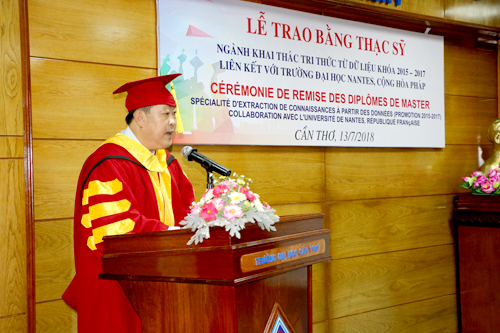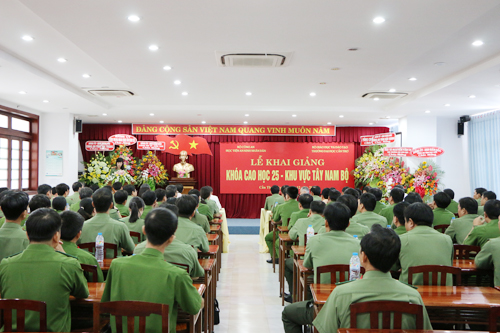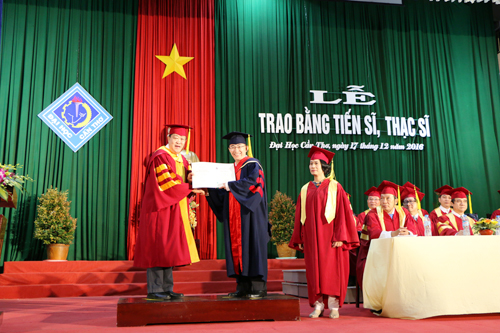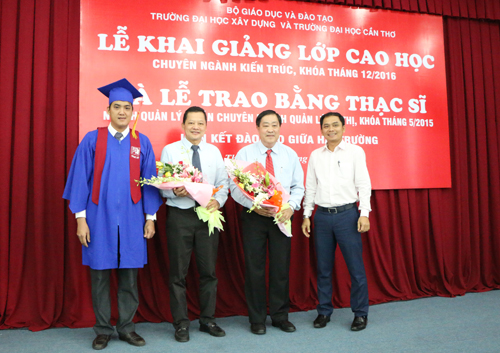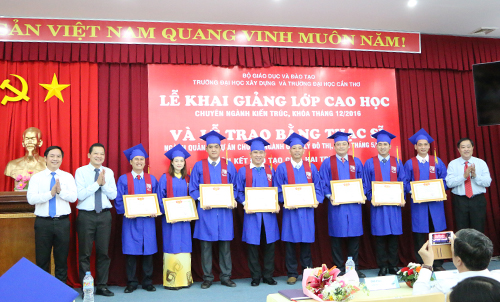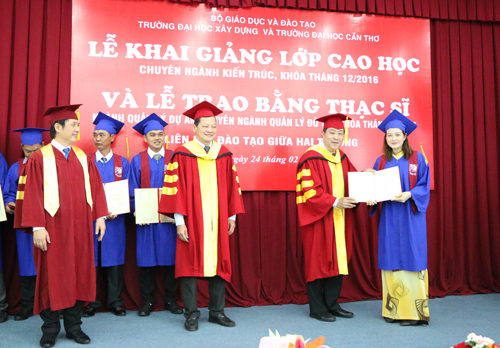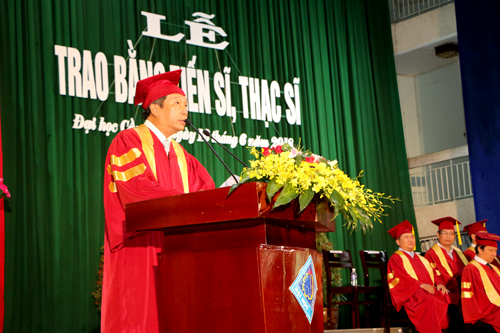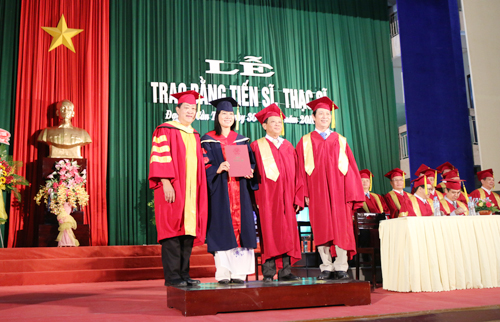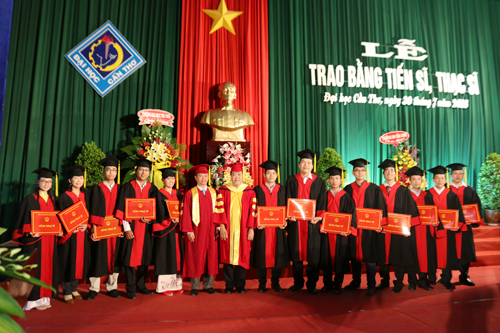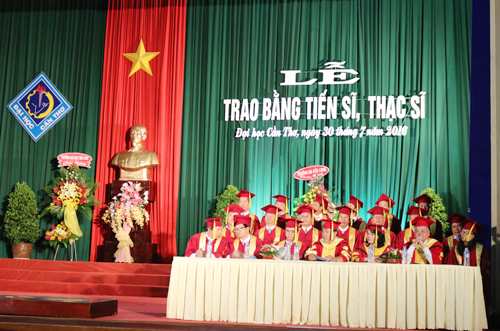
 Tên đề tài: “Nghiên cứu pheromone giới tính và nấm ký sinh trong phòng trị sùng khoai lang (Cylas formicarius Fabricius) tại Đồng bằng sông Cửu Long” .
Tên đề tài: “Nghiên cứu pheromone giới tính và nấm ký sinh trong phòng trị sùng khoai lang (Cylas formicarius Fabricius) tại Đồng bằng sông Cửu Long” .
 Tác giả: Phạm Kim Sơn, Khóa 2010 đợt 1.
Tác giả: Phạm Kim Sơn, Khóa 2010 đợt 1.
 Chuyên ngành: Bảo vệ thực vật; Mã số: 62620112. Nhóm ngành: Nông - Lâm - Ngư nghiệp.
Chuyên ngành: Bảo vệ thực vật; Mã số: 62620112. Nhóm ngành: Nông - Lâm - Ngư nghiệp.
 Người hướng dẫn chính: PGS.TS. Trần Văn Hai, Trường Đại học Cần Thơ.
Người hướng dẫn chính: PGS.TS. Trần Văn Hai, Trường Đại học Cần Thơ.
- Tóm tắt nội dung luận án
Đề tài: “Nghiên cứu pheromone giới tính và nấm ký sinh trong phòng trị sùng khoai lang (Cylas formicarius Fabricius) tại Đồng bằng sông Cửu Long” được thực hiện nhằm mục tiêu:
- Nghiên cứu xây dựng qui trình tổng hợp và điều chế mồi pheromone giới tính của SKL theo hướng đơn giản, rẽ tiền, hiệu suất cao, phù hợp với điều kiện phòng thí nghiệm.
- Xác định loài nấm ký sinh có hiệu lực phòng trị SKL cao trong phòng thí nghiệm.
- Đánh giá hiệu quả phòng trị của pheromone giới tính tổng hợp và nấm ký sinh đối với SKL ở điều kiện ngoài đồng.
Kết quả nghiên cứu cho thấy:
Kết quả điều tra 100 hộ nông dân tại 3 xã Thành Đông, Thành Trung và Tân Thành, huyện Bình Tân, tỉnh Vĩnh Long có thâm niên canh tác khoai lang cao, đa số trên 10 năm, với diện tích từ 0,6-1 ha, chủ yếu giống khoai lang Tím Nhật, có lợi nhuận khá cao, trồng 1 vụ/năm. Tất cả nông hộ điều tra (100%) đều sử dụng thuốc hóa học để phòng trị các loài gây hại như sùng khoai lang, sâu ăn lá, dế nhũi và bệnh thối dây, nông dân có biết về pheromone giới tính của SKL, chưa qua sử dụng. Kết quả khảo sát ngoài đồng trên 9 ruộng khoai lang cho thấy có 19 loài côn trùng và 1 loài nhện hại trên khoai lang. Trong đó, các loài sâu ăn tạp, ruồi đục lòn, rầy phấn trắng và bọ dưa xuất hiện phổ biến. Có 10 loài thiên địch xuất hiện, trong đó, kiến ba khoang và nhện lùn là 2 loài phổ biến nhất và tần suất xuất hiện cao nhất. Nghiên cứu biện pháp phòng trị mới an toàn, thân thiện với môi trường để quản lý sự gây hại của SKL tại vùng ĐBSCL, là giải pháp cần thiết làm giảm thiểu hoặc thay thế dần thuốc hóa học độc hại.
Hợp chất (Z)-3-dodecenyl-(E)-2-butenoate (Z3-12:E2), pheromone giới tính của SKL, đã được tổng hợp thành công bằng con đường tổng hợp thông qua phản ứng Wittig với các chất phản ứng ban đầu là 1,3-propanediol, 1-nonanal và Crotonyl chloride. Trong đó, phản ứng Wittig được điều chỉnh để tổng hợp chọn lọc cấu hình Z (cis) của nối đôi trong phân tử. Quy trình tổng hợp này đã rút gọn lại còn 5 bước so với 8 bước trước đây. Mồi pheromone giới tính tổng hợp (0,3-1 mg/túyp) được điều chế từ ống cao su non Việt Nam cho hiệu quả hấp dẫn SKL cao tương đương với mồi điều chế từ tuýp cao su Aldrich (Đức). Dạng bẫy nước cho hiệu quả bắt giử sùng đực cao hơn so với bẫy dính. Bẫy đặt đứng cạnh luống khoai và cửa bẫy ngang tán lá khoai cho hiệu quả hấp dẫn sùng tốt nhất. Khảo sát diễn biến mật số SKL bằng bẫy pheromone giới tính tại huyện Bình Minh và Bình Tân, tỉnh Vĩnh Long cho thấy mật số SKL không phụ thuộc vào lượng mưa và nhiệt độ môi trường mà phụ thuộc vào thời vụ khoai lang trên đồng ruộng và mật số sùng chủ yếu tăng mạnh vào giai đoạn gần thu hoạch hoặc các ruộng khoai lang lân cận thu hoạch. Mật số sùng giảm xuống khi nông dân chuyển đổi cơ cấu cây trồng, nhất là luân canh với lúa.
Kết quả phân lập, định danh theo phương pháp truyền thống và giải trình tự DNA trên vùng ITS-rDNA đã xác định 7 mẫu phân lập nấm Metarhizium thu thập ở ĐBSCL chỉ là loài nấm Metarhizium anisopliae. Theo phương pháp sinh học phân tử, sử dụng kỹ thuật PCR, giải trình tự DNA trên vùng ITS-rDNA và dựa vào cơ sở dữ liệu ngân hàng gen đã khẳng định 7 mẫu phân lập nấm Metarhizium thu ngoài tự nhiên thuộc loài nấm Metarhizium anisopliae. Trình tự DNA các mẫu phân lập nấm M. anisopliae có độ tương đồng cao (từ 97,5-99,7%).
Đánh giá hiệu lực của các mẫu phân lập nấm xanh trong PTN cho thấy các chủng nấm xanh M. anisopliae có hiệu lực gây chết sùng rất cao, đạt 96,5-100% ở 5 ngày sau xử lý. Sùng đực bị nhiễm nấm xanh (109 bào tử/ml) có khả năng lây lan bệnh và gây chết cho các cá thể khác với hiệu lực trên 90% từ 9 ngày sau khi thả sùng tiếp xúc. Hiệu quả của nấm xanh đối với SKL ở dạng nấm tươi là nhanh và cao hơn so với dạng bột khô, xử lý bằng hình thức phun cho hiệu quả cao hơn rãi nấm. Sùng cái khỏe mạnh bắt cặp với sùng đực đã bị lây nhiễm nấm xanh bằng cách cho tiếp xúc với nấm trực tiếp hoặc thông qua mồi pheromone giới tính có thời gian sống và số lượng con sinh ra giảm có ý nghĩa so với sùng cái bắt cặp với sùng đực bình thường.
Kết quả đánh giá ngoài đồng ở các huyện Duyên Hải (Trà Vinh), Tri Tôn (An Giang), Cù Lao Dung (Sóc Trăng) và Bình Tân (Vĩnh Long) cho thấy biện pháp đặt 6-12 bẫy pheromone/ 1.000 m2 kết hợp với phun và rãi nấm xanh cho hiệu quả làm giảm tỷ lệ gây hại của SKL tương đương (ở Duyên Hải và Bình Tân) hoặc có hiệu quả cao hơn (ở Cù Lao Dung và Tri Tôn) so với biện pháp áp dụng thuốc trừ sâu hóa học theo cách nông dân. Tuy nhiên, các khảo sát ngoài đồng chưa thể hiện rõ hiệu quả cộng hưởng của bẫy pheromone giới tính và nấm xanh phòng trị SKL qua diễn biến số lượng sùng vào bẫy và tỉ lệ thiệt hại trên củ do sùng gây hại.
- Những kết quả mới của luận án:
So với các công trình trước đây, nghiên cứu tập trung vào một số điểm mới cơ bản sau:
Đề tài là công trình nghiên cứu đầu tiên về xây dựng quy trình tổng hợp, điều chế và áp dụng pheromone giới tính để phòng trị SKL theo hướng đơn giản, rẽ tiền, có hiệu quả cao, phù hợp với điều kiện ĐBSCL, tạo ra sản phẩm pheromone giới tính có độ tinh khiết cao, sử dụng các hóa chất trong quy trình tổng hợp khá an toàn so với các con đường tổng hợp trước đây. Quy trình này có điều chỉnh phản ứng tổng hợp chọn lọc cấu hình Z rút gọn lại còn 5 bước.
Ứng dụng sinh học phân tử xác định loài chủng nấm xanh Metarhizium anisopliae ký sinh trên côn trùng thu thập ngoài tự nhiên vùng ĐBSCL, sử dụng kỹ thuật PCR, giải trình tự vùng ITS-rDNA so với các mẫu Metarhizium trên thế giới từ cơ sở dữ liệu ngân hàng gen để so sánh trình tự vùng ITS-rDNA và đánh giá độ tương đồng của các chủng nấm thu thập.
Đánh giá hiệu quả của pheromone giới tính tổng hợp đối với SKL ở ngoài đồng tại huyện Bình Tân, Vĩnh Long. Khảo sát ứng dụng của pheromone giới tính tổng hợp kết hợp với nấm xanh trong quản lý sự gây hại của SKL ở ngoài đồng tại vùng ĐBSCL.
Dựa vào các kết quả tìm được của đề tài có thể mở ra hướng ứng dụng pheromone giới tính tổng hợp kết hợp với nấm xanh phòng trị SKL có hiệu quả bền vững nhằm giảm thiểu hoặc thay thế dần việc sử dụng thuốc trừ sâu hóa học.
- Khả năng ứng dụng trong thực tiễn:
Luận án đã đề xuất quy trình tổng hợp, điều chế mồi pheromone giới tính của SKL theo hướng đơn giản, giá thành rẽ, độ tinh khiết cao, phù hợp với điều kiện phòng thí nghiệm có thể áp dụng để sản xuất mồi pheromone giới tính tổng hợp.
Luận án đã đề xuất quy trình áp dụng bẫy pheromone giới tính tổng hợp của SKL ở ngoài đồng theo hướng đơn giản, rẽ tiền, hiệu quả cao, phù hợp với điều kiện canh tác khoai lang tại vùng ĐBSCL. Điều này giúp giảm thiểu hoặc thay thế dần thuốc trừ sâu hóa học độc hại.
Kết quả đề tài cho thấy áp dụng pheromone giới tính kết hợp với nấm xanh cho hiệu quả phòng trị SKL bằng hoặc cao hơn so với tập quán phòng trị sùng của nông dân sử dụng thuốc trừ sâu hóa học. Do đó, biện pháp mới này có thể áp dụng quản lý sùng ngoài đồng thay thế dần việc sử dụng thuốc trừ sâu hóa học của nông dân trồng khoai lang theo chiến lược IPM.
Các ruộng khoai lang có áp dụng bẫy pheromone giới tính tổng hợp kết hợp với phun và rãi nấm xanh đều có tỉ lệ thiệt hại trên củ thấp hơn hoặc bằng so với đối chứng (nông dân). Có thể tập huấn chuyển giao quy trình này cho nông dân trồng khoai lang ứng dụng quản lý SKL.
Công trình nghiên cứu là các dữ liệu khoa học cơ bản cung cấp thông tin khoa học cho việc cập nhật bổ sung kiến thức giảng dạy lĩnh vực Sinh thái học hóa chất ứng dụng trong sản xuất nông nghiệp và nghiên cứu trong các đề tài tương tự.
Người hướng dẫn Nghiên cứu sinh
Trần Văn Hai Phạm Kim Sơn
INFORMATION OF DOCTORAL DISSERTATION
Research title: “The study of sex pheromone and entomopathogens in control of the sweet potato weevils (Cylas formicarius Fabricius) in Mekong Delta”.
Major: Plant protection Code: 62 62 01 12
Doctoral candidate: Pham Kim Son
Major supervisor: Assoc. Prof. Dr. Tran Van Hai
Academic Institution: Can Tho University
- Summary of the dissertation
Title: “The study of sex pheromone and entomopathogens in control of the sweet potato weevils (Cylas formicarius Fabricius) in Mekong Delta” was conducted for the following objectives:
- To study and develop the process of synthesizing and preparing sex pheromone lure of sweet potato weevils under the simple, cheap and effective instructions appropriate to the laboratory conditions.
- To determine species of entomopathogens which can be used to control sweet potato weevils in laboratory.
- To evaluate the application effectiveness of sex pheromone and entomopathogens to sweet potato weevils under field conditions.
The research results showed:
100 farmers in 3 communes: Thanh Dong, Thanh Trung and Tan Thanh of Binh Tan District, Vinh Long Province had high seniority of growing sweet potato with the majority of over 10 years and the area range of 0,6-1 ha. They mainly grew Japanese sweet potato with high profits for 1 crop/ year. All surveyed farmers (100%) used chemical to control sweet potato weevils, leaf-miners, mole crickets, stalk rot. Farmers knew about sex pheromone of sweet potato weevils. Survey result at field conditions in 9 sweet potato fields showed that there were 19 species of harmful insect and 1 type of spider in sweet potato. In which, armyworm and whitefly appeared popularly. 10 species of natural enemy appeared, in which staphylinidae and dwarf spider were 2 common ones with highest frequency. New safe and friendly treatments were studied in order to control the damage of sweet potato weevils in the Mekong Delta and they were essential methods to reduce or replace hazardous chemical pesticides.
(Z)-3-dodecenyl-(E)-2-butenoate (Z3-12:E2), sex pheromone of SPW were synthesized via Wittig with 1,3-propanediol, 1-nonanal and Crotonyl chloride. In which, Wittig was adjusted to select configuration Z (cis) of double bonds in molecular. This process was reduced with only 5 steps instead of 8 steps. Synthetic sex pheromone lures (0,3-1 mg/tube) were prepared from uncured rubber tube of Vietnam which had similar attraction effectiveness as Aldrich (Germany). Water trap had higher effectiveness of capturing weevils than sticky trap. Trap with door position at the leaf canopy had the best effectiveness of attraction. The survey of the development of SPW’s population by using sex pheromone trap at Binh Minh District, and Binh Tan District, Vinh Long showed that SPW’s population did not depend on rainfall and temperature. It related to sweet potato crops. Weevil’s population increased at harvesting period and decrease when farmers shifted the cultivating structure, especially the rotation with rice.
The identification results according to traditional method determined 7 isolated samples of Metarhizium anisopliae. According to molecular biology method, using PCR techniques, sequences of DNA in ITS-rDNA region and genbank affirmed that 7 isolated samples was M. anisopliae, with high similarity (97,5-99,7%).
The evaluation of effectiveness of isolated samples of Ma in laboratory showed that M. anisopliae had high effectiveness in killing weevils at 96,5-100% at 5 days after treating. Male weevils infected Ma (109 spores/ml) can transmit the disease and cause the death to weevil’s population at 90% after 9 days. Fresh fungi Ma had higher effectiveness than powder-form fungi. Moreover, spraying fungi had higher effectiveness than spreading fungi. Female weevils and male weevils contacted with sex pheromone and infected Ma had shorter lifetime and lower number of young weevils.
The evaluation results at Duyen Hai (Tra Vinh), Tri Ton (An Giang), Cu Lao Dung (Soc Trang) and Binh Tan (Vinh long) showed that 6-12 pheromone traps/ 1.000 square meters combined with spraying and spreading had similar effectivenss of controlling weevils (at Duyen Hai and Binh Tan) or higher effectiveness (at Cu Lao Dung and Tri Ton) in comparison with using chemical pesticides. However, in-field surveys did not show resonant effectiveness of sex pheromone traps and Ma in controlling SPW through number of weevils captured in traps and the incidence.
- New findings of the dissertation:
In comparison with previous studies, the research focused on the following views:
It is the first study on develop the process of synthesizing, preparing and applying sex pheromone to control sweet potato weevils under simple, cheap and effective instructions appropriate to the conditions of the Mekong Delta. It created sex pheromone products with high pure level. Safe chemicals were used during the process of synthesizing. This process adjusted synthetic reactions to reduce Z configuration into 5 steps.
Molecular biology was used to determine species of Metarhizium anisopliae on pests collected in the nature of the Mekong Delta, PCR technique, the sequences of ITS-rDNA region compared to samples of Metarhizium in the world from the database of GenBank were used to compare the sequences of ITS-rDNA region and evaluate the similarity of collected species of fungus.
It evaluated the effectiveness of sex pheromone to sweet potato weevils at fields in Binh Tan District, Vinh Long Province. It studied on the application of synthetic sex pheromone combined with Metarhizium anisopliae in controlling the damages of sweet potato weevils at fields in the Mekong Delta.
Based on findings of the study, it introduced a new application of synthetic sex pheromone combined with M. anisopliae in controlling sweet potato weevils with sustainable effectiveness in order to reduce or replace the application of hazardous chemical pesticides.
- Practical applicability:
The study recommended the process of synthesizing, preparing and applying sex pheromone lures of sweet potato weevils under simple and cheap instructions and high pure level that were appropriate to the laboratory conditions.
The study recommended the process of applying sex pheromone trap of sweet potato weevils under simple, cheap and effective instructions appropriate to the field conditions in the Mekong Delta. It helped reduce or replace the application of hazardous chemicals.
The research findings showed that the treatment effectiveness of applying synthetic sex pheromone combined with M. anisopliae of sweet potato weevils was similar or significantly higher than the application of chemical pesticide. Therefore, this new method could be used in controlling weevils at field and replace the application of chemical pesticides.
Sweet potato fields applied sex pheromone trap combined with sprays of Metarhizium anisopliae had similar or lower rate of damage than the control group (farmer). It is possible to train and transfer this process to farmer and control sweet potato weevils.
The research results would be the scientific basis to provide information for updating and supplementing teaching knowledge in the field of Ecology applied in agricultural production and similar studies.
Supervisor Doctoral candidate
Tran Van Hai Pham Kim Son
>> Xem chi tiết nội dung luận án
>> Xem thông tin đăng tải tại Website Bộ giáo dục và Đào tạo.





